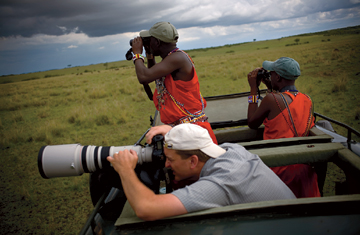
SEARCH MISSION: Jackson Tinka, standing, scans the horizon for game
After we pull our land rover off the track to watch a pair of leopards, I ask my two safari guides what animal they'd be most excited to see. I'm thinking elephants, lions, rhinos — the charismatic megafauna that attract tourists from across the world. Their answer: aardvarks and porcupines, the reclusive nocturnal residents of Kenya's Masai Mara. "I took care of cattle on the Mara when I was a boy," says Jackson Tinka, 21. "So I've seen a lot of wildlife."
Tinka and his companion are what was until recently a rarity in Kenya's biggest-drawing game park: tour guides working in the land of their fathers. Though the vast stretch of savanna lies in territory owned by the Masai, until a few years ago the red-robed pastoralists made up less than 20% of those employed in its camps and lodges. Those who could find work did so mostly as low-paid camp guards. Yet there's a growing realization that the Masai and the 590-square-mile (1,530 sq km) national reserve share a common future. The tribe's fortunes will most likely be found in the tourists who provide Kenya with the bulk of its foreign exchange — and in the wildlife those tourists pay to see. (See pictures of Kenya.)
The next day, I join Tinka and a group of other Masai on a drive out of the protected reserve into Masai communal grazing lands. The only sign that we've crossed over is a line of cow tracks. Zebra and topi antelope graze under acacia. Tinka points out branches stripped of bark. "They have been cleared by elephants," he says. A few more bends in the road and we've arrived at the Koiyaki Guide School, where Tinka is one of 26 students being trained for work in the reserve.
The compound's low green buildings include dorms, a small library, a large classroom and a specimen room, where students can study animal bones, insect specimens and snakes in plastic jars. Founded in 2005, the school is an effort to provide the Masai with income as well as investing in them the importance of conservation. The students learn the habits of the local wildlife, and just as importantly the expectations and behaviors of those that come to see it. Foreign accents are a particular challenge. "The other day, we took a group and they were asking me questions," says Tinka. "I couldn't understand anything they said."
Only a small part of Masai land has been set aside as reserve. Most of it lies in communal and private hands, where cattle graze alongside herds of eland and antelope. During the annual migration, floods of zebra and wildebeest arrive from Tanzania, and more elephants feed outside the protected area than in it. "Wildlife is just as good as any other gold," says Jackson Looseyia, 41, one of the first Masai to work as a guide in the reserve and co-owner of Rekero, the eight-tent camp where we stay the night.
Fortunately, in Rekero and other small, upscale lodges, the Masai are also increasingly seen as a valuable asset. That night at dinner, I sit next to Helen Cotter, an English tourist who has come to celebrate her 50th birthday. She had seen all the animals she had wanted, but it's her guide she raves about. The young Masai man explained his culture, including the wild plants his tribesmen use to clean their teeth. "They don't go out and buy Colgate, do they?" she tells me. Says Looseyia's partner Gerard Beaton: "The tourists all come for the animals, but in the end it's the people that touch them."
See 50 authentic American travel experiences.
Got an awful travel gripe? The Avenger may be able to sort it out for you. Click here to tell us your problem.
